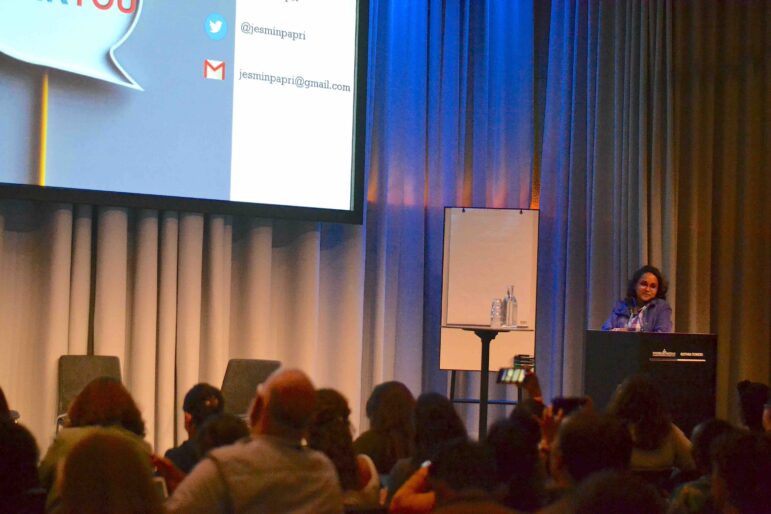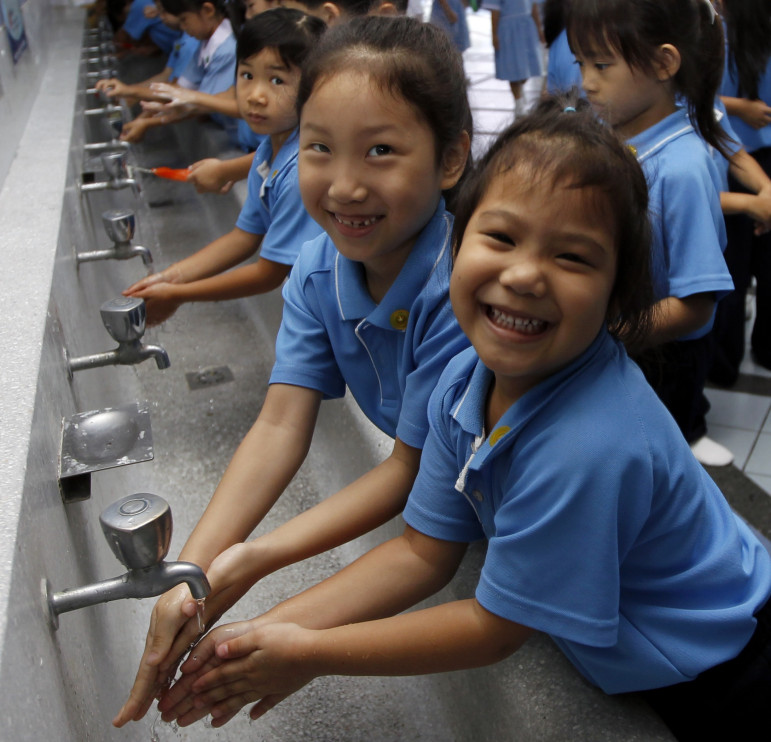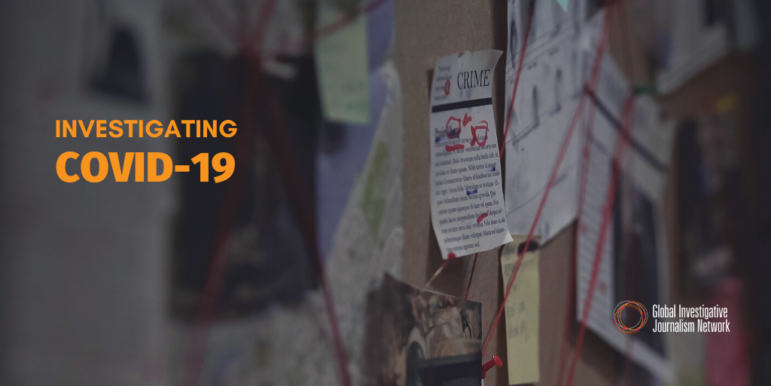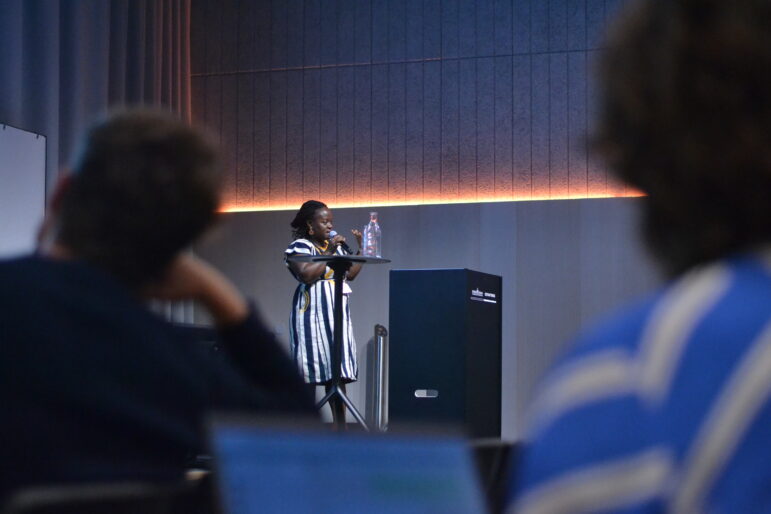

Le Monde investigative reporter Stéphane Horel, Salud con lupa Director Fabiola Torres, Bangladeshi reporter Jesmin Papri, and British Medical Journal Investigations Editor Madlen Davies (left to right) at the Healthcare Investigations panel at GIJC23. Image: Ellen Lindqvist Karsberg for GIJN
As the world’s health risks continue to evolve, dedicated health journalists have never been more important. Reporters diligently wade through the facts on some of the most critical issues of our time — the threat of a new pandemic, downstream effects of climate change, fallout of poverty, female reproductive issues, and even the food that makes it onto our plates.
In this panel at the 13th Global Investigative Journalism Conference (#GIJC23), four leading health investigative journalists from France, Peru, Bangladesh, and the United Kingdom discussed their work and shared tips and best practices for those wishing to apply the same methodology to their investigative reporting.
Corporate Influence on Scientific Research
Investigative journalist for Le Monde, Stéphane Horel, reports on corporate crime, pesticide and chemical industries, and food and tobacco lobbying. Her work often touches on the commercial determinants of health — in other words, the health impacts that result from the political activity of corporations.
She told conference attendees how corporations and associated lobbying firms often manipulate scientific papers on health matters to shape the opinions of decision makers.
Horel showed email correspondence that was revealed as part of the Monsanto Papers, which won Le Monde a European Press Prize in 2018. In the exchange, a Monsanto employee, discussing a scientific paper, writes, “I have gone through the entire document and indicated what I think should stay, what should go, and in a couple of spots I did a little editing.”
Corporations from all sectors have used tactics like these for decades, Horel says. “What they have in common is they fight what is considered, to them, uncomfortable knowledge. The way [they] do this is by highlighting uncertainty, minimizing the evidence, and attacking and undermining scientists.”
Tips for looking into corporations and their potential influence on scientific reports.
- Look at the regulatory and legal context. When researching a product, check whether there are upcoming regulations surrounding it. Regulatory changes often “create a context where corporations produce lobbying material that has the appearance of science, just to defend their product,” Horel said.
- Check who’s funding the science. Always look for the financial source behind a study or review. “It has been shown statistically,” she noted, “that the source of funding for a study has an impact on the result.” There are often disclosures at the end of scientific papers stating that corporations have funded the work, and even reviewed the draft.
- Speak to experts. It is essential to find the key person to guide you through the literature, so that you have an accurate grasp of the science in the area that you’re focusing on. Read Horel’s advice on collaborating with scientists.
- Background the authors. Ask questions about those named on the paper. Who are the authors, and who are they affiliated with?
- Don’t be impressed by white coats. Scientists are humans who carry their own biases, Horel said. “Science is also a battlefield,” she told attendees. “You don’t have to be intimidated by someone who has a scientific title.”
Tracing Pesticides Across Borders
Salud con lupa, a Peru-based digital platform covering public health in Latin America, focuses on corporations, environment, and inequalities. At GIJC23, the outlet’s director, Fabiola Torres, discussed their investigation A Hidden Poison on My Plate, which sought to answer viral TikTok questions about a blue substance found on supermarket fruit and vegetables in Peru.
Teaming up with three civil society organizations, Torres and her team sent 84 samples collected from large supermarkets for multi-residual analysis at a certified laboratory. More than 50 of the tested fruits and vegetables, from six separate supermarkets, exceeded the maximum limits of pesticide residues allowed for consumption.
“Who sold us dangerous pesticides in our country?” Torres asked. “Highly dangerous pesticides that are banned or prohibited in the European Union and the United States. This was our work.”
Torres and her team then began following Peru’s pesticide imports and exports. “The chemical pesticides business has several paradoxes, because they sell in our country products that are prohibited, but when we have to export this food, they say that we can’t feed our crop with these kinds of products,” she says. “They manufacture all of these products in their territories, and then circulate them in countries that have flexible regulations.”

Salud con lupa investigated the cross-border use of pesticides in Peru. Image: Screenshot, Salud con lupa
Torres recommends using the database Beyond Pesticides, which offers information connecting these chemicals with resulting health problems, and The International Code of Conduct on Pesticide Management from the World Health Organization, which sets out voluntary standards of conduct for those operating in the industry.
Creating databases with information gathered from Freedom of Information (FOI) requests is also essential, she says. Speaking to GIJN after the session, she reiterated: “Most of the time we request for public information, and we build databases. Most of the databases that we need for investigative journalism are not in the public domain.”
Linking Climate Change and Reproductive Health
Jesmin Papri is an investigative journalist from Bangladesh, who has reported on how climate change has damaged the reproductive health of women in the country’s coastal areas where rising seas have contaminated freshwater supplies. In an investigation for Mongabay, she reported on the health risks posed by washing menstrual cloths in saltwater.

Bangladeshi investigative reporter Jesmin Papri addresses panel on healthcare investigations at GIJC23. Image: Ellen Lindqvist Karsberg for GIJN
“My reports showed that the use of saltwater harms the uterus over time,” she told the GIJC23 audience. “This leads to various diseases including heavy bleeding, PID (pelvic inflammatory disease), and so on. The poorer rural women who can’t afford long-term medical treatment choose a hysterectomy.”
Papri interviewed women who were hesitant to discuss such personal problems, many of whom were not even listed in Bangladesh’s record of public health. At first, she believed that their symptoms were caused by waterborne disease due to water scarcity and subsequent poor hygiene levels.
Her success, however, came from sensitively building up relationships with the women and dogged on-the-ground reporting, which included speaking to pharmacies, doctors from coastal areas, and the women’s families. After much persistence, she uncovered the root causes of the high local level of hysterectomies.
“This story gave me some peace,” she said. “It was a way of paying back my people and the place where I belonged.”
Getting Started
Madlen Davies, investigations editor of the British Medical Journal and chair of the panel, spoke to GIJN after the session about her advice for journalists who want to investigate healthcare issues.
“A lot of my work is bread-and-butter journalism,” she said. “The bulk of the work is finding experts, looking at whether those experts have conflicts of interest, and speaking to as many people as possible to get stories.”
Torres also shared her advice for investigative journalists entering the field.
“Understand the context, because the health industry is big business — the biggest business in the world,” she said. “You have to connect how the industry is linked with business, and with political, economic, and social problems. It’s not just one tree, but all of the forest.”









